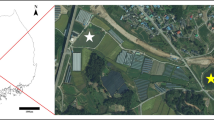Abstract
Invasive amphibians have considerable negative impacts on recipient ecosystems, however, impact has been assessed for only a few species, limiting risk assessments. In particular, the impact of invasive anurans with carnivorous tadpoles have not been examined thoroughly. The Indian bullfrog (Hoplobatrachus tigerinus), native to the Indian sub-continent, is rapidly invading the Andaman archipelago, Bay of Bengal after its recent introduction. We aimed to evaluate the effect of carnivorous H. tigerinus tadpoles on two species of endemic anuran tadpoles Microhyla chakrapanii and Kaloula ghoshi, in a mesocosm experiment. Rapid predation by larval H. tigerinus resulted in no survival of endemic frog tadpoles. Survival of H. tigerinus was density-dependent. The study is timely in elucidating the impact of invasive larval H. tigerinus on native anurans and substantiates the need to manage invasive populations (or potential incursions) of the species on the Andaman archipelago and elsewhere.

Similar content being viewed by others
References
Babbitt KJ, Tanner GW (1998) Effects of cover and predator size on survival and development of Ranautricularia tadpoles. Oecologia 114(2):258–262
Cabrera-Guzmán E, Crossland MR, Shine R (2013) Competing tadpoles: Australian native frogs affect invasive cane toads (Rhinella marina) in natural waterbodies. Austral Ecol 38(8):896–904
Capinha C, Seebens H, Cassey P, García-Díaz P, Lenzner B, Mang T, Moser D, Pyšek P, Rödder D, Scalera R, Winter M (2017) Diversity, biogeography and the global flows of alien amphibians and reptiles. Divers Distrib 23(11):1313–1322
Chelgren ND, Rosenberg DK, Heppell SS, Gitelman AI (2006) Carryover aquatic effects on survival of metamorphic frogs during pond emigration. Ecol Appl 16(1):250–261
Daniels RR (2005) Amphibians of peninsular India. Universities Press, India
Dash MC, Hota AK (1980) Density effects on the survival, growth rate, and metamorphosis of Rana tigrina tadpoles. Ecology 61(5):1025–1028
Dinno, A. (2017). R package dunn. test ‘Dunn’s test of multiple comparisons using rank sums’ version 1.3.5
Dutta SK (1997) Amphibians of India and Sri Lanka: checklist and bibliography. Odyssey Publishing House
Govindarajulu P, Altwegg R, Anholt BR (2005) Matrix model investigation of invasive species control: bullfrogs on Vancouver Island. Ecol Appl 15(6):2161–2170
Grosjean S, Vences M, Dubois A (2004) Evolutionary significance of oral morphology in the carnivorous tadpoles of tiger frogs, genus Hoplobatrachus (Ranidae). Biol J Linn Soc 81(2):171–181
Harikrishnan S, Vasudevan K (2013) Recent introduction and spread of Indian bullfrog Hoplobatrachus tigerinus (Daudin, 1802) into the Andaman Islands. Aliens 33:42–43
Harikrishnan S, Vasudevan K (2018) Amphibians of the Andaman and Nicobar Islands: distribution, natural history, and notes on taxonomy. Alytes 36(1–4):238–265
Khan MS (1996) The oropharyngeal morphology and feeding habits of tadpole of Tiger frog Rana tigerina Daudin. Russ J Herpetol 3(2):163–171
Kiesecker JM, Blaustein AR (1997) Population differences in responses of red-legged frogs (Rana aurora) to introduced bullfrogs. Ecology 78(6):1752–1760
Kiesecker JM, Blaustein AR, Miller CL (2001) Potential mechanisms underlying the displacement of native red-legged frogs by introduced bullfrogs. Ecology 82(7):1964–1970
Kupferberg SJ (1997) Bullfrog (Rana catesbeiana) invasion of a California river: the role of larval competition. Ecology 78:1736–1751
Measey GJ, Vimercati G, Villiers FA, Mokhatla M, Davies SJ, Thorp CJ, Rebelo AD, Kumschick S (2016) A global assessment of alien amphibian impacts in a formal framework. Divers Distrib 22:970–981
Mohanty NP, Measey J (2018) What’s for dinner? Diet and potential trophic impact of the invasive Indian bullfrog on the Andaman archipelago. PeerJ. https://doi.org/10.7717/peerj.5698
Mohanty NP, Measey J (2019) Reconstructing biological invasions using public surveys: a new approach to retrospectively assess spatio-temporal changes in invasive spread. Biol Invasions 21(2):467–480
Pyšek P, Richardson DM, Pergl J, Jarošík V, Sixtová Z, Weber E (2008) Geographical and taxonomic biases in invasion ecology. Trends Ecol Evol 23:237–244
Saidapur SK (2001) Behavioral ecology of anuran tadpoles: the Indian scenario. Proc-Indian Natl Sci Acad Part B 67(6):311–322
Saidapur SK, Veeranagoudar DK, Hiragond NC, Shanbhag BA (2009) Mechanism of predator–prey detection and behavioral responses in some anuran tadpoles. Chemoecology 19(1):21–28
Shine R (2010) The ecological impact of invasive cane toads (Bufo marinus) in Australia. Q Rev Biol 85(3):253–291
Smith KG (2005a) Effects of nonindigenous tadpoles on native tadpoles in Florida: evidence of competition. Biol Conserv 123(4):433–441
Smith KG (2005b) An exploratory assessment of Cuban treefrog (Osteopilus septentrionalis) tadpoles as predators of native and nonindigenous tadpoles in Florida. Amphib Reptil 26(4):571–575
Smith KG (2006) Keystone predators (eastern newts, Notophthalmus viridescens) reduce the impacts of an aquatic invasive species. Oecologia 148(2):342. https://doi.org/10.1007/s00442-006-0370-y
van Wilgen NJ, Gillespie MS, Richardson DM, Measey J (2018) A taxonomically and geographically constrained information base limits non-native reptile and amphibian risk assessment: a systematic review. PeerJ 6:e5850
Vimercati G, Hui C, Davies SJ, Measey GJ (2017) Integrating age structured and landscape resistance models to disentangle invasion dynamics of a pond-breeding anuran. Ecol Model 356:104–116
Acknowledgements
This research was supported by the DST-NRF Centre of Excellence for Invasion Biology (CIB). We would like to thank, the Department of Environment and Forests, Andaman and Nicobar Islands for granting permits (#CWLW/WL/134/350); the Rufford Small Grants (#20818-2) for funding and the Department of Botany and Zoology, Stellenbosch University for a bursary to NPM; the Andaman Nicobar Environment Team (ANET) for facilitating field work; Saw Isaac and Anand James Tirkey for collecting part of the data and assistance in the field; the Long term ecological monitoring network (LEMoN), National Centre for Biological Sciences (NCBS) for providing temperature data; Susan Canavan for feedback on the manuscript. NPM would like to acknowledge the support and advice of Dr. Manish Chandi, Adhith Swaminathan and Mahima Jaini during the study.
Author information
Authors and Affiliations
Corresponding author
Additional information
Publisher's Note
Springer Nature remains neutral with regard to jurisdictional claims in published maps and institutional affiliations.
Electronic supplementary material
Below is the link to the electronic supplementary material.
Rights and permissions
About this article
Cite this article
Mohanty, N.P., Measey, J. No survival of native larval frogs in the presence of invasive Indian bullfrog Hoplobatrachus tigerinus tadpoles. Biol Invasions 21, 2281–2286 (2019). https://doi.org/10.1007/s10530-019-01985-z
Received:
Accepted:
Published:
Issue Date:
DOI: https://doi.org/10.1007/s10530-019-01985-z




